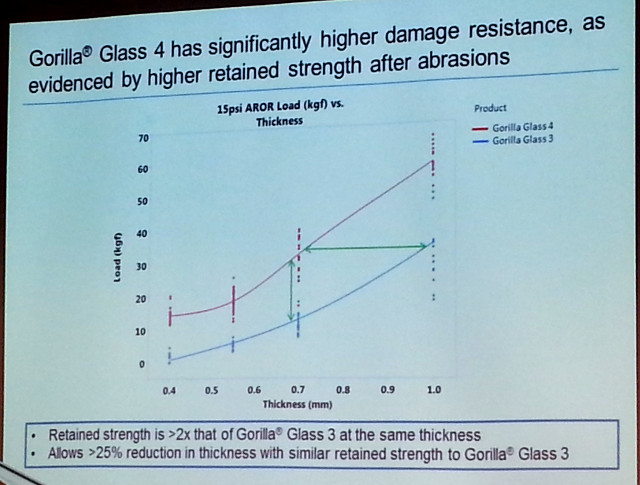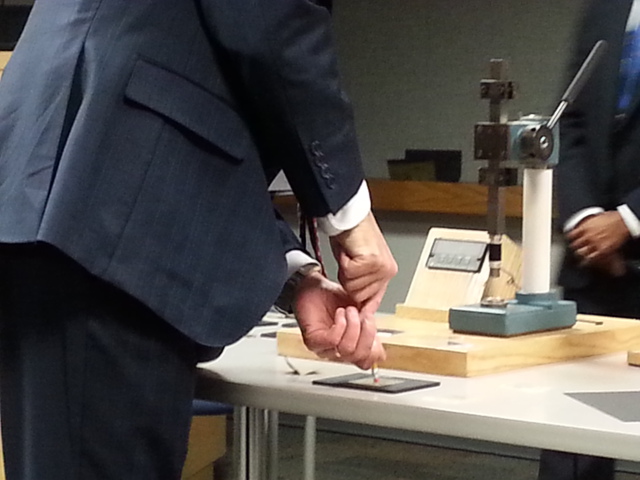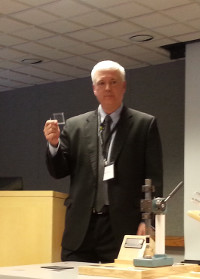Display Materials & Manufacturing – In a special press event held at Corning’s New York Headquarters, the company revealed its latest innovation – Gorilla Glass 4. The company provided impressive test results showing the performance of this cover glass material, which is aimed at mobile devices.
It is already in production and available on smartphones today, although announcements of the specific brands and products will not be disclosed for a few weeks yet.
Insight Media was one of only two North American media companies at the event, which was dominated by daily and trade press media from China, Korea and Taiwan. We spent the entire day there and have a lot to report on, which will be rolled out in several articles.
The key top level message from Corning was the performance improvement that Gorilla Glass 4 offers over Gorilla Glass 3 and competitive cover glass offerings, including sapphire. Key metrics include:
- Gorilla Glass 4 is up to two times tougher (more damage resistant) than competitive glasses.
- Gorilla Glass 4 survives up to 80 percent of the time in a 1 meter drop test to a rough surface.
- Soda-lime glass, as deployed in today’s commercial devices, breaks nearly 100 percent of the time in the same 1 meter drop test.
- Handset makers can achieve a >25% reduction in thickness for the same retained strength.
Gorilla Glass 4 (GG4) was developed specifically to address the number one concern of handset makers and consumers – screens that break due to everyday drops. But handsets may not necessarily see all the benefits of GG4 in new devices. That’s because the handset or mobile device makers have a choice: they can use the same thickness GG4 cover glass and receive two times the damage resistance; or, they can choose to use a thinner cover glass but only get some of the performance benefits (they diminish as the glass gets thinner). For example, 0.7mm GG4 glass has the same or better performance as 1.0mm GG3 glass (see separate article detailing new tests, measurements and significance).

Unfortunately, history has shown that manufacturers have so far chosen the thinner glass over performance benefits despite breakage being such a concern with them and consumers. Only time will tell if history repeats itself.
In a special panel Q&A session at the end of the day, Corning representatives answered a number of questions about the technology and markets for GG4.
In terms of products for the cover glass, smartphones will be the first products to roll out with tablets and at least one notebook to follow. Initial product announcements are expected soon, but some may be delayed until the World Mobile Congress time frame (early Feb 2015). It was also noted that there is a trend by handset makers to slim down the number of models as they see how some companies can be very successful with only a few models (Apple).
We asked if Corning had done drop tests with sapphire materials as well since there has been so much discussion about this material lately. The answer is yes, but not a lot so far. According to Dr. Jaymin Amin, a Division VP of Technology for Gorilla Glass, they did drop tests on five samples of sapphire to a granite surface and found that all cracked from a 60 cm height. By comparison, the same thickness GG4 glass had no failure when dropped at up to 2.2 meters in height.
Jon Pesansky, Technology Manager for Product Performance and Reliability in Corning’s Specialty Materials group did a second test demo for the media participants. Called an abrasion test, you take a sample of material (0.55mm in thickness in this case) and try to break it with the erasure end of a pencil. Pesansky performed this test on pristine samples of soda lime glass, Gorilla Glass 4 and sapphire and none of them broke. Then, he slightly abraded the surface with some sandpaper which is typical of the kind of abrasion you might get from a phone in a dirty pocket or handbag. Both the soda lime glass and sapphire broke easily now with a small pressure from the pencil, but he could not break the Gorilla Glass 4 sample.

Pesansky thinks these tests demonstrate that while sapphire is very resistant to scratches, it is brittle and has a low damage resistance (will break easily in falls or if slightly abraded). That’s why he is confident GG4 will find wide adoption and sapphire won’t.
Corning plans to continue its branding campaign for Gorilla Glass that it started in 2010 with a new set of ads and videos that will begin appearing immediately. This will include a social media campaign but little print advertising. Cliff Hund, GM and President of Corning East Asia noted that Gorilla Glass already has a high 80% name recognition with consumers and the main reason consumers visit the website is to see if their phone uses Gorilla Glass. Corning is also in discussions with the handset and mobile device makers about expanding this branding as part of their promotional offerings.
 As for cost, Sr. VP and GM for Specialty Materials, Jim Steiner said that there would be a cost premium for GG4 over GG3, but the exact amount would depend on many factors in the customer relationship. Hund noted that consumers can spend up to $150 or even more with product warranties to fix/repair damaged screens, but the price premium for GG4 “would be way less than that”.
As for cost, Sr. VP and GM for Specialty Materials, Jim Steiner said that there would be a cost premium for GG4 over GG3, but the exact amount would depend on many factors in the customer relationship. Hund noted that consumers can spend up to $150 or even more with product warranties to fix/repair damaged screens, but the price premium for GG4 “would be way less than that”.
We also asked what was on tap for GG5. Steiner said the company was already working on additional improvements pointing to what he called “3D shapes”. This means the ability to create non-flat cover glass. This can include glass that curves around the edge of the phone, for example. He noted that Corning has developed a unique one-mold forming process that can create these 3D shapes with Gorilla Glass and that do not need any additional finishing, unlike conventional two-mold techniques. The company now has a pilot production line running with a partner company called G-TOC in Taiwan that it hopes will soon begin mass production.
Gorilla Glass was introduced in 2006 and it took about 5-6 years to reach a cumulative total of 1 billion devices sold with the material. Today, that total stands at 3 billion devices and with GG4, Corning expects it will take only another 2 years to reach 6 billion devices. That’s a pretty impressive ramp.
Steiner summed up the advancements by saying that he thinks GG4 represents the most significant innovations within Gorilla Glass since its launch. He should know – he has been there from the beginning. – Chris Chinnock

